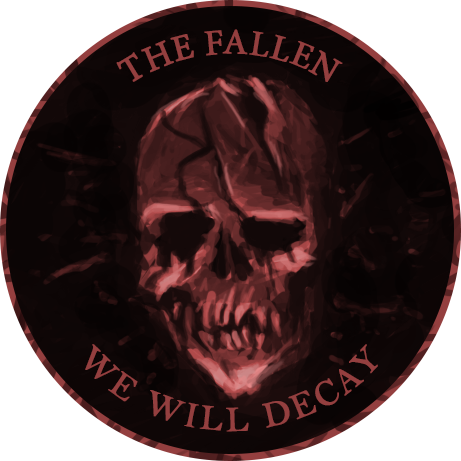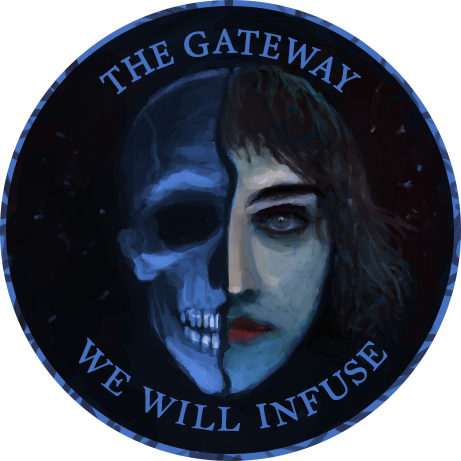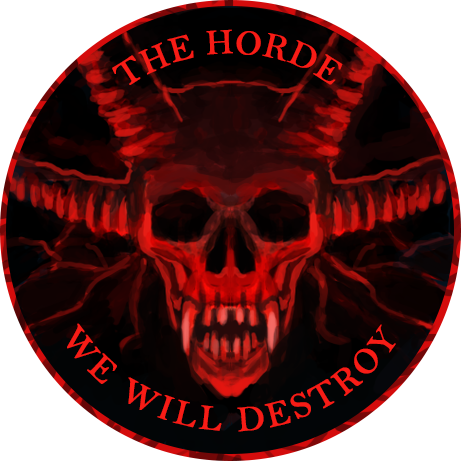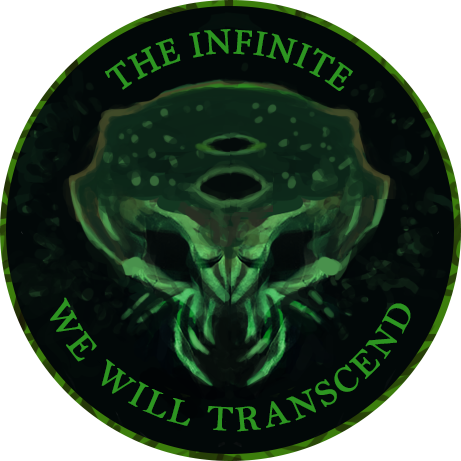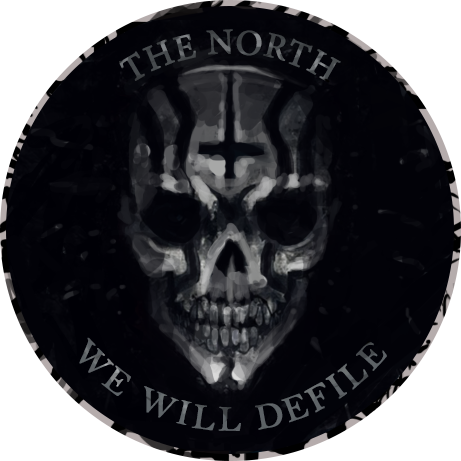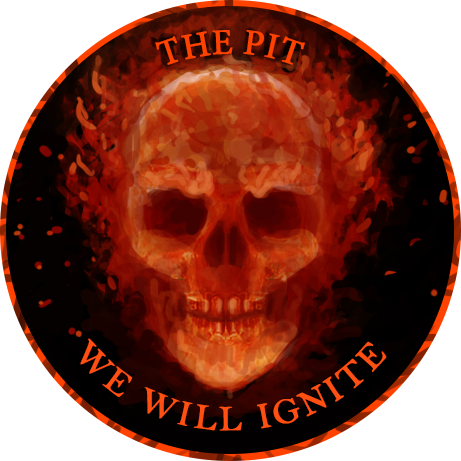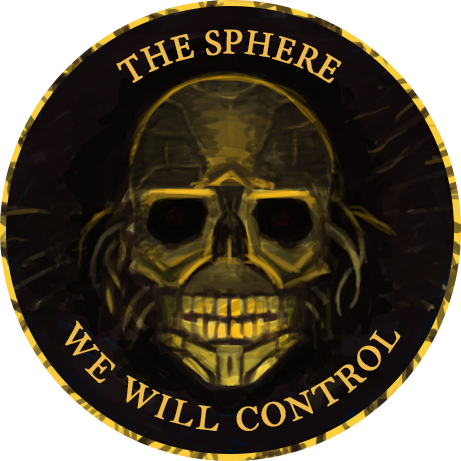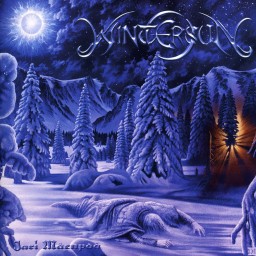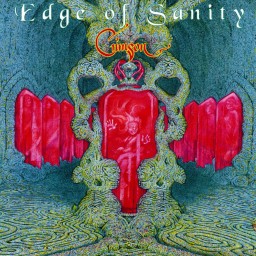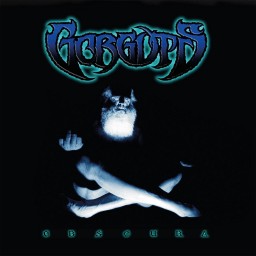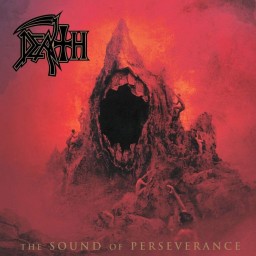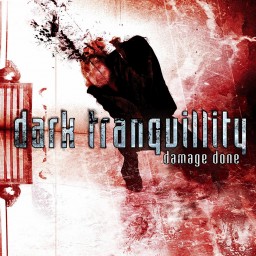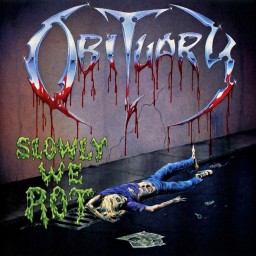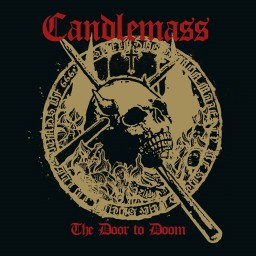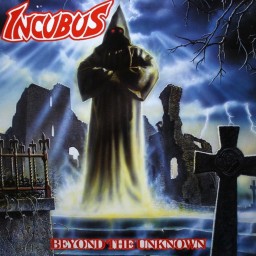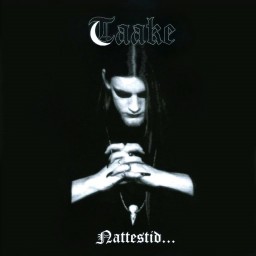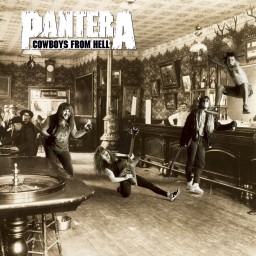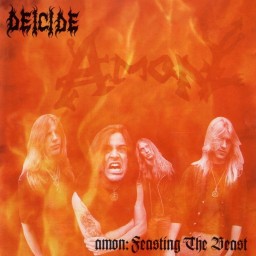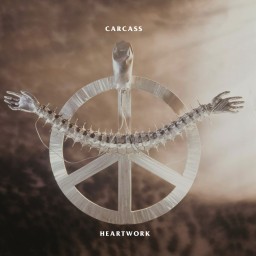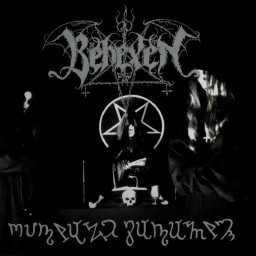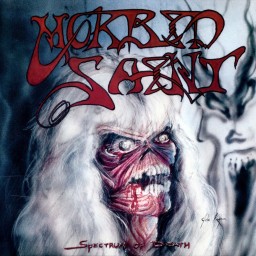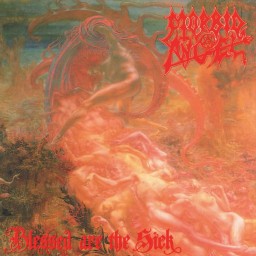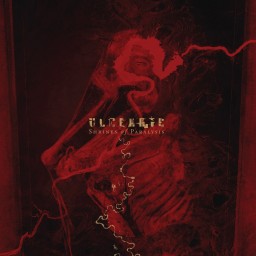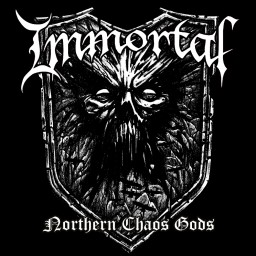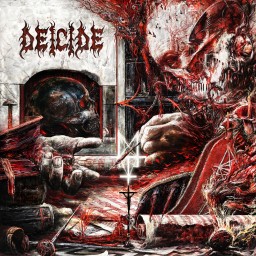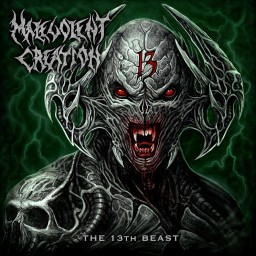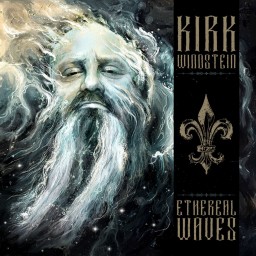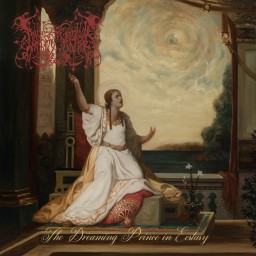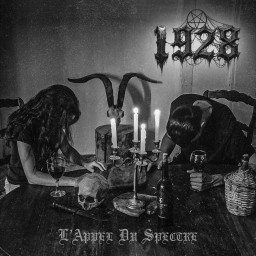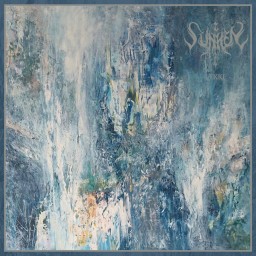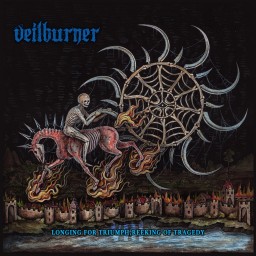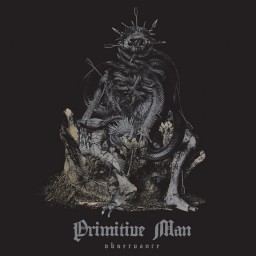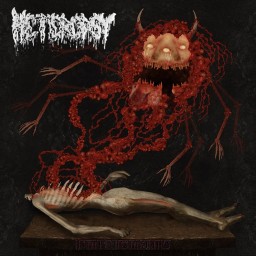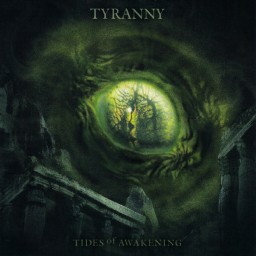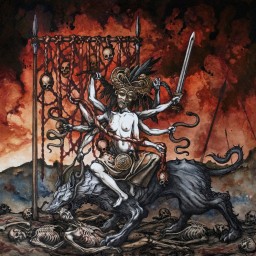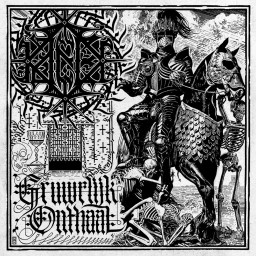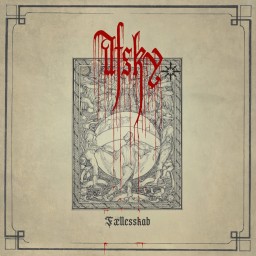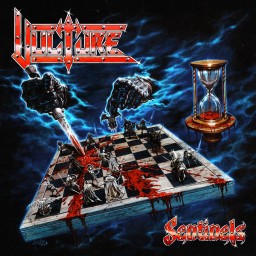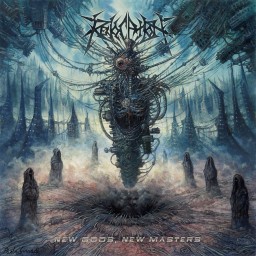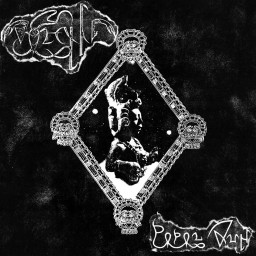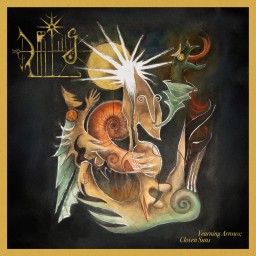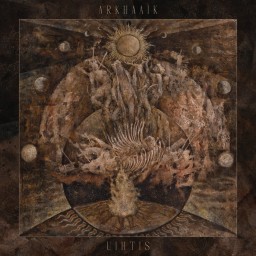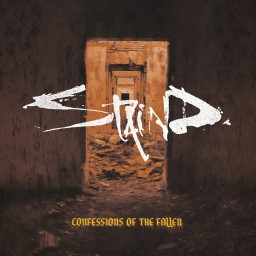Vinny's Reviews
Sigh!
For the first few seconds of the opening track of this album I was struggling to see how this had anything to do with Death Metal. Having heard only black metal style vocals over poppy guitar work, I am still no nearer if I am honest. The internet tells me that this is Symphonic Death Metal. I don't believe everything I read on the internet for a reason.
There's no power behind much of anything on display here and so I am left to hope that some catchy songwriting or sonic wizardry is awaiting me over the coming tracks. It isn't though! The tempo and structure suggests that this could be a folk metal album, except they forgot to write any actual folk parts to any of the tracks. As a result it just sounds like overtly jolly heavy metal with a black metal vocalist who has no friends who like black metal so he's had to join any band he can find.
If I am forcing myself to find any positives and not just look like a miserable bastard then I would say that the lead work is of actual note and clearly the work of an adept guitarist. The rest of I found a real struggle to get through with no spark or even palatable consistency to cling to I do confess to hitting the skip button more than once in search of something of interest.
The lyrics to track number three Sleeping Stars sum up the experience perfectly for me:
"Suddenly I feel a
warmth go through my body,
but I feel that a
part of me has died."
The "warmth" might have been wind though.
Genres: Death Metal Power Metal
Format: Album
Year: 2004
More than a little reminiscent of early Opeth, fellow Swedes Edge of Sanity where a late 80's/early 90's progressive death metal band. They released eight albums before finally calling it a day in 2003 (after previously doing so in 1999). As I have already alluded to, the likeness to the sound of their countrymen is hard to ignore. It is not that one band copied the other I suspect. Sweden just clearly had a plethora of talented progressive metal heads throughout the 90's and they couldn't possibly all fit into one band.
Crimson actually is one song album split into parts depending on what version you look at. A one song album in 1996 was a bold and brave move but the fact that Dan Swanö's name is on the liner notes should tell you all you need to know. As with most things he touches Crimson is ambitious to say the least but is backed up by deft playing and clever songwriting. The progression on here is well measured, tempered almost to maximise the enjoyment. Considering it is just one song the record never gets boring as it changes pace and tempo well during its expansion over forty minutes.
It requires a close ear to be given to it in order to truly appreciate the vast and intricate nature of the entire offering. But anytime spent with this record is time well spent. It will take you through death, progressive and at times gothic elements of metal and blend all of the styles together with a real deftness. To date it is the only release from the band that I have sought out to listen to and such is my satisfaction with it I have not yet felt the need to venture further into their back catalogue. I really can't recommend this enough.
Genres: Death Metal Progressive Metal
Format: Album
Year: 1996
Enter the avant-garde, bass twanging, bone-jarring branch of Gorguts that seems to cause equal amounts of praise and revulsion across the death metal fan base. I sit firmly in the praise camp. Not that I don't get the challenges that people have with this directional shift from the bands previous releases (all respectable enough DM records), but for me what impresses me the most about Obscura is the sheer range and scope of the album. It isn't perfect by any means but, as per my love of Colored Sands this record likewise retains death metal as its core source, despite the multi-layered influences on display here Obscura does still come across as a raging death metal record full of energy and rampant angst.
Lemay's trademark demented shriek accompanies the instrumentation perfectly. I find the music twists and contorts perfectly throughout, taking the listener on a real journey. The only real downside to that journey perhaps is the length of it. Clocking in at an hour in duration, the record does meander a bit unfortunately. Although it is stylistically refreshing it is not controlled enough in its delivery to be able to sustain a presence for such a long period of time. To compare it with the aforementioned Colored Sands is a fair contrast really as the latter album absolutely nails the delivery of the avant-garde/experimental aspect by integrating it into the overall sound better, even though the run time is more or less the same the 2013 album feels more palatable.
From reading the criticism of Obscura there's definitely a feeling of the album being something that is done to the fans as opposed to being something they feel is introduced to them. As full on as it is, the record is still fun and an entertaining enough curved ball.
Genres: Avant-Garde Metal Death Metal
Format: Album
Year: 1998
Albums grow on you for different reasons. As an avid fan of most of Death's earlier releases I didn't find the same levels of entertainment in much of anything after Spiritual Healing. Whilst I could more than see the talent and skill involved in the direction that Chuck was taking Death's sound, progressive elements of metal have only recently become of interest to me - over the last 12 months say - so for a number of years the majority of the bands later releases gathered some dust on my shelves. I now find myself oddly in the reverse mindset where I prefer the later output to the initial three releases. For me The Sound of Perseverance is the crowning glory in this more progressive style of death metal, largely because the whole thing just feels so natural and effortless.
Oddly for death metal, there are lots of feel good vibes for me on this record. The chords sound more open but the riffs are just as cutting as you would expect from one of the founding fathers of death metal. Whilst obvious, the time changes are not intrusive and feel clean and polished. Again these are traits i would not attribute to me gleaning enjoyment from in terms of my more extreme tastes but they work so well with the confidence and aptitude of Schuldiner, Hamm, Clendenin and Christy.
The band sound like they enjoyed making the record, such is the warm feel to proceedings. They almost tease the listener during Story To Tell, with their stop/start playing leaving you wondering if the track is over or whether another time change is due. There's an accessibility to proceedings that is reminiscent of almost rock music proportions, only Chuck's grim vocals and the chugging riff passages keep you of the understanding this is still a death metal record at its core. The creepy atmospheric bass and guitar interlude during Flesh and The Power it Holds also adds the necessary levels of menace you'd expect.
In terms of criticisms (what is keeping that half star off the score) I have two. Firstly, the cover of Priest's Painkiller is both out of place in the greater context of the album and also not a very good cover either. Secondly, the album is a tad too long with the cover on here. In terms of flow it is all mapped out superbly as an album but it just falls at the end unfortunately.
Genres: Death Metal Progressive Metal
Format: Album
Year: 1998
My melodic death metal tastes aren't really that wide in scope as I tend to dwell in the more extreme end of my tastes in death metal generally. Without wishing to generalise too much I find most bands that fall under this sub-genre to be underwhelming. Why would I want my death metal to be melodic, ergo more accessible is the question that has remained largely unanswered for the past 30 or so years of listening to metal. Dark Tranquillity were still a new band for me until today, but sadly they have brought little in the way of reasoning for my opinion of the melodic side of death metal to change much.
I mean it is very melodic, don't get me wrong. There's keyboards galore on display as well as melodious guitar parts, but none of it sticks with me. The riffs feel aggressive enough but they don't really set anything on fire for me and so come off as being restrained or blunted somehow. Stanne's vocals aren't awful by any means but just come across to my ears as being very generic ad tired sounding.
The album seems to go on and on as a result of my struggles it seems with only really track twelve standing out as the album closes with it's adept instrumentation bringing a memorable ending to proceedings. Again, I don't report that the band are doing anything wrong here, I know that the issue lies more so with me than anything they are trying to achieve. To a convert of the melodic death metal sound it probably will have more stars against it's name. I however struggle to give much of anything to the release.
Genres: Death Metal
Format: Album
Year: 2002
As intros to death metal go, mine wasn’t too shabby. I bought “Slowly We Rot” blind, in the days of (me) having no internet and just a sick logo and equally sick artwork to tickle my pubescent fancy! I had never even heard any death metal at that point but I instantly loved every fucking minute of this record.
I had to play it at my grandparents house and luckily my grandad had a great stereo set up. When he first heard the record he thought he had something wrong with his equipment. I had to convince him for a good few minutes that it was supposed to sound like that.
I was instantly enthralled by Tardy’s vocal style and remember thinking how insane it was that a human could make such a noise. It was like a dumped high school girl puking and sobbing her hatred for boys out with only the occasional word actually audible through all the hatred and vitriol.
The atmosphere on the record scared the shite out of me, like some soundtrack to some mind-bending horror film. The record plays like a writhing, shifting mass of fetid, acrid evil just toying with the listener and taking great pleasure in doing so. The riffs on here are fucking scathing too so any flesh left on your bones from the Tardy onslaught is soon detached once the riffs kick in. Peres and West made a great partnership, leaving as much of an impact with their six strings as Tardy did with his vocal chords.
Although end to end this is a thoroughly ferocious affair it does lose me sometimes, not necessarily out of complexity more out of if sounding a little samey in places. Still though this is a benchmark Death Metal album for me based on both nostalgia and the overall genre impact it had.
Regrettably I sold my vinyl copy of this record and now don’t even have it on stream but I can still recall every track and every terrifying Tardy howl.
Genres: Death Metal
Format: Album
Year: 1989
Candlemass 2019 are epic. I mean in terms of the sound at least. This plays more like an epic heavy metal record as opposed to a doom record. Yeah, the heavy drudging riffs are still there but there's a real sense sword-wielding, bicep popping warriors flanked by women in metal underwear sat on spiky horses type fantasy. Opening track "Splendor Demon Majesty" is an unashamedly dark opener full of occult promise that pulls of a perfect balance of menacing worship of evil deities whilst also pacing superbly to open the album strongly. Even the most doomy tracks here are still laden with such vocal stylings. "Astorolus - the Great Octopus" (great fucking song title) is an obvious choice here, even given Iommi's input it still doesn't stray to far away from the epic nature the song title and feels well balanced. It rumbles and rolls like a great Octopus would do assisted by some superb lead work along the way that stab through the menacing atmosphere. Likewise, the gallop of "Death's Wheel" drops down in pace to doomy depths for the chorus to become one of the nearest experiences to the 1986 debut heard on here.
Let's be honest though folks, this isn't "Epicus..." part two. Not that anyone really wanted that though, right? On its own, "The Door to Doom" stands up as a fantastic record for a band who haven't released anything notable since "Tales of Creation". It is not that recognisable as a Candlemass record though which will no doubt get the diehards moaning into their retro flares and skull effect candlestick holders whilst crying into their earthen drinking vessels full of mead. The only real reminders on here of the doom relationship is the fact that the record on the whole reminds me of a much better version of "13". As I sit listening to "Black Trinity" I hear so much similarity to numerous tracks from Sabbath's last full length that I had to look twice in the instrumental parts to make sure I didn't the library on shuffle.
That withstanding, "House of Doom" is a superb doomy romp with monumental riffage and pace and horror themed synths to build the atmosphere to boot. This was on the the EP of the same name from last year and is probably may favourite track on here certainly in terms of its authenticity to the Candlemass sound of old, chiming church bells ringing to fade as the track closes. If anything the record gets doomier the final 2 tracks. Check out the riffs on "The Omega Circle" if you still need your bed wetting from some punishing doom metal before the band signs off on a job well done.
There is only really two criticisms I can level at the record, one being the utterly pointless filler of "Bridge of the Blind", a crap ballad dropped in after just 3 tracks of excellence is just out of place both in terms of the timing of its placement and the marked difference in pace from the rest of the album. Secondly, too many tracks start the same way. There's about 3 or 4 that start with some slow picked strings and Languist crooning as an introduction to the tracks proper. It just gets old after the second or third time even though on each occasion the track is soon hit by an epic riff or stomping pace change,
Sadly, if it wasn't for the shit ballad this album would have afforded a higher rating as it makes very few bad steps along it's length. Buy it for the love of metal though, not just because it's Candlemass.
Genres: Doom Metal
Format: Album
Year: 2019
Death/Thrash or Thrash/Death? Does it really matter? Whichever style you believe has most traction in the calculated attack of Opprobrium (known as Incubus to the older audience), it certainly makes for an authentic and entertaining listen. For me the Thrash elements act like explosions of flavour, giving notes of energetic bitterness. The menacing death metal atmospheric dirge is still the more prominent factor in the sound but both elements are akin to some acceptable collaboration between the genres with neither one ever truly outweighing or outdoing the other. Like two warring factions have decided to call it quits and just try and get along as best they can!
The authenticity comes from that sound on the production that gives the impression that this was recorded in someone’s garage, yet the quality of the songwriting leaves the listener with structures that suggest it may have been planned in the office of an architect.
This is the kind of album that makes a consistent entry on thousands of music blogs about “Underrated/Unsung Classics” from the 90s. And the majority of those bloggers are right. There’s nothing here that is any dramatic step down from the nefarious and menacing death/thrash of “Seven Churches”. “Beyond...”punches well within its category but never quite reaches the furious delivery of Demoltion Hammer. The latter just works hard on the jab whilst “Beyond...” has a more varied sack of sucker punches that strike from behind its darker guard.
At just eight tracks, the sophomore release from these guys feels like a real clear cut, transparent statement of intent. Turn up, put it down and get it out there, and it is this immediacy of the record that really appeals. The band name may have changed but this album remains exactly as good as I remember it first time of listening.
Genres: Death Metal Thrash Metal
Format: Album
Year: 1990
The debut full-length from Taake came at the arse-end of the second wave era of BM. By 1999 nobody was burning churches anymore, bands weren't killing each other's members and many stalwarts of the genre had already drifted to a more experimental sound. The success of 'Nattestid...' at first glance seems surprising, yet a couple of listens unearths an album built on a foundation of solid songwriting, supported by razor sharp steel riffage and decorated with a consistent theme permeated by some subtle yet lasting nuances to maintain its hellish Feng Shui.
For all the cold and scathing guitar here there's more than a fair share of melody, whether that is rooted in the viking style passages or just the more obvious folk leanings of the album. Whenever it is there, it seems effortlessly measured. It never takes the edge off the raw energy of the tremolo and nor does the cutting of the riffs blunt the impact of the more melodious elements. Throughout the album the bass and drums maintain a strong presence (especially on instrumental track, 'Vid IV ') and Hoest himself, shrieks and rasps along like some demented high priest undertaking some satanic and nefarious ritual. There is an edge to the guitar throughout more or less the entire record that sounds a little too hazy at times which I can only put down to the production job (yes I know it is a BM album, but nonetheless it remains my only gripe).
It is easy to see from the seven tracks on show here that Hoest's talent for accomplished and consummate songwriting was already well developed at this early stage of his career. Frostein's deft contributions on both drums and bass make these visions whole. Considering the two man line up it is an album that has a vastness in scope that belies the small number of contributors.
The menacing and creepy looking artwork on the album sums up the nightmarish soundscape inside perfectly. The minimal approach to the tracklisting earns kvlt/troo points by the bucket load.
Genres: Black Metal
Format: Album
Year: 1999
A shuffle playlist in my hotel room this past week threw up 'Heresy' from this record and I have ended up playing the whole record through in my head before getting home and playing the CD. In the 90's this record occupied a near constant place in the top 4 of my 'most played', alongside 'Painkiller', 'Arise' and 'Seasons in the Abyss' it got span to death over nearly the whole decade. There was so much that appealed to my established taste at the time yet also equal amounts of new and enticing sounds to absorb, all delivered with a fervour and ferocity that was literally breathtaking. In so many ways, playing this for the first time was like listening to something that was nothing like anything I had heard before, yet at the same time there was enough reference points to breed the necessary amount of familiarity for me to engage with it instantly.
Although this does not retain the top slot in my favourite Pantera list, it holds enough nostalgia and tangible feelings still of the initial awe of the discovery to always have an important place in my evolution through the genre.
There has always been a real sense of cohesion to me about the sound of Pantera. They are like some well oiled machine with just enough AI in it's computer parts to deliver flare and panache instead of just routinely processing the same parts over and over again. Whether it is the shrill wailing of Anselmo, the chunky stick work of Vinnie, the rumbling current of Brown or the insane string wizardry of Dimebag you focus on, they are all there together as a unit. Yes, for me the overarching memory post-listen is those fucking riffs, but the structures they form part of are also key to their impact.
I enjoy the darker side of the album's sound. 'Medicine Man', 'Message in Blood' and 'The Sleep' stand out as a trio of tracks that add a real depth to an album that given its relentless approach could otherwise lose you towards the end. Pantera seem to "grow" with the progress of the record which is rare in most releases that have frequented my headphones since the 90s.
Does it stand up well as a singular release some 29 years later? Not quite for me, even with the memories these 12 tracks hold for me I can't avoid the need for a couple of tracks to be trimmed ('Heresy' and 'Shattered') to really cement five stars in the rating for this review.
Genres: Groove Metal
Format: Album
Year: 1990
I am not a fan of compilations generally. I usually see them as opportunistic releases designed to boost the coffers of the associated record company who have been fortunate enough to scoop the demo recordings or greatest hits rights to a band's back catalogue. That withstanding, 'Amon: Feasting The Beast' actually has relevance beyond appealing to just the avid uber-fan of Deicide. It is a release that showcases the raw talent, energy and commitment of the band before they became the death metal household name we all recognise to be Deicide.
There's still some turkeys on here, the second attempt at 'Sacrificial Suicide' sounds like Benton has a lisp and is just ridiculous, for example. However, as a release of a piece of death metal history, 'Amon...' stands up well enough. It is hard to get too excited by it, likewise difficult to extend paragraphs enough to stretch to a full review of the release.
Genres: Death Metal
Format: Compilation
Year: 1993
There are very few albums nowadays that I can recall track by track in my head. The fact that ‘Heartwork’ still plays through my memory some 26 years after I first heard it is testimony to it being a big part of my metal journey and also the catchy nature of the songwriting. I get that it is a departure from previous direction and that for many it was a step too far away from the more familiar sound of the band, but “Heartwork” was still a strong metal record and still recognisable as Carcass regardless.
My rating of 3.5 stars really only reflect my transition towards their earlier material as I have aged. “Heartwork” gets less rotation than “Symphonies...” or “Reek...” do, but at the same time will always have that element of nostalgia present to give it a solid rating. Whether it is the energetic start to the title track or the chop n chug of “No Love Lost” or even the spiralling maelstrom of “This Mortal Coil”, there’s still variety on this record.
As a melodic death metal album this just about has enough edge still to cut the mustard with my more extreme tastes. Often it gets criticised almost as an album that let the band down in some way, but I don’t think that is fair as it still stands up as a successful turn of direction for Carcass as well as being a defining record for the melodic death metal movement.
Genres: Death Metal
Format: Album
Year: 1993
'Rituale Satanum' stands up as a glorious exploration of how true aggression can be ported onto an audible format with pure aplomb and genuine heartfelt hatred. Some of the riffs on show here are truly demonic and when coupled with those rasping and harsh vocals make for great effect on one of BM's most under-rated releases. The melodic elements whilst not always as obvious to the ear are there in the background like some dark, melancholic tidal current that churns up sightless, shrieking beasts in it's waves.
From the menacing spoken word to 'Intro (The Summoning)' we are instantly into the scathing guitar that opens 'Sota valon jumalaa vastaan" which straight up lashes away at the listener for its entire duration. 'Night of the Blasphemy', whilst no less intense in the delivery, offers that melodic element to give additional structure to the chaotic riffing and blasting. 'Christ Forever Die' with its more measured approach to the track offers a well-paced build to the track whilst losing none of the looming threat built so far over the first three tracks. The hatred and vitriol for the icon of the subject matter from the track title is obvious as ever in the vocals here. They act like some scorching wind that you could envisage peeling the flesh from the face of the holy one just by virtue of the wickedness behind them, spat like acid onto the face of the crucified man. I find that the instrumentation and arrangement of the song actual temper the vocals really well also.
One of the real successes of 'Rituale Satanum' is that whilst it remains unrelenting in delivery it never feels like a drain to listen to in one sitting. Rampant BM records like 'Battles in the North' or 'Pure Holocaust' do lose me at times despite my enjoyment of them. I think the unexpected moments such as the lead work on 'Towards the Father' keep things interesting and challenging without showing any dip in the fury on display.
The big build up to 'Saatanan varjon synkkyydessä' feels like the start of some epic heavy metal track but soon becomes that familiar slaughtering paced frenzy, yet there's great structure to pace the track out to retain some of the majesty built in the intro to the song, to bridge the chaos in between solid start and finish sections and add a funereal set of keys to finish.
My favourite track on the album is 'Baphomet's Call', it has an almost easy feel to how it drops around some light riffing into an almost foot tapping pace. It plays like some old rock track given the Satanic treatment with it's death metal like layered growls midway through. 'The Flames of the Blasphemer' is just as harsh as the track title indicates but again makes great use of melody to manage the flow of the track. There's also an almost NWOBHM feel to the pace here as well, although the return of the funereal keys soon stamps sufficient atmosphere on proceedings to remind me that this ain't no Diamond Head record.
The final two tracks work superbly to give a almost grandiose ritual(e) feel to the closing part of the record. The solid drumming of 'Blessed Be the Darkness' and demented shrieks of the vocals that share space with spoken word recitals midway through the track weigh a dense atmosphere to proceedings. By the time we get through the closing (and title) track with its slow pace there's a real sense of finality and closure, like as a listener we have been through some torrid and yet positively memorable experience.
Genres: Black Metal
Format: Album
Year: 2000
If you have been paying attention to my musings in The Pit Clan Challenge then you won't be surprised to find that I have given this record four stars. It characterises that rabid and vicious thrash metal that I enjoy so much and only the fact that some of the production work on this is truly terrible (as in beyond being able to simply be considered kvlt or cool) then a full five stars would have been easily awarded.
For sheer lack of fucks given the album scores about a ten at least, this is a record forged out of complete abandon of compromise. It starts off relentlessly and ends up the same without once letting up. Every aspect to it feels bestial and evil in the most primitive sense. Whether it is the menacing vocals with their sneer of derision and mocking undertone, the bashing fury of those drums or even the manic strumming of the bass underneath the charging dual guitar attack, it all has a fee for antediluvian values throughout.
Considering the band started out some six years before recording this by just playing Priest, Maiden, Sabbath and Crüe covers, what they eventually got to transcribe to record was far removed from their covers days. This is crude and unrefined music for ears of fans who genuinely don't care too much for compositional excellence or song writing prowess. Each track has one intention, to rip your fucking face off! And they do it, eight times in a row.
As I mention above, the main issue here is the production job sounds terrible. Notwithstanding the fact that it kind of suits the ideal in so many ways it is too obvious even for my extreme metal scarred ears for me not to notice. Instead of charging the energy in the record it kind of blunts it a little bit although I still get multiple lacerations after each spin of this record.
Genres: Thrash Metal
Format: Album
Year: 1990
Blessed Are The Sick" is still as relevant now as it was 20 + years ago, with its sonic wizardry, beefed up guitar sound (when compared with its predecessor at least) and the furious thunder of Sandoval on the drum kit driving forward this beast of a record. The complimentary lead work of Richard and Trey (Richard and his more melodic moments to temper Trey with his swarming, chaotic and sonic shredding) works superbly and you get a real sense that this is band much improved ability wise from their previous outing.
The maturity is evident and the whole package has a more serious edge to it with the album artwork grotesque and twisted like the sound of the considerably darker music within. The intro is a perfect opener with the almost engine like noise of some hellish machine made from crying children and grinding bones being revved up to floor the accelerator and destroy all in its path. By the time it gives way to opener proper "Fall From Grace" you are sat bolt upright waiting for the assault to happen and your are not going to be disappointed as the track smothers you in glorious low end marauding DM.
The build up to the title track is varied with each track managing to stand out as individual points of brilliance. The fury of "Brainstorm", the sudden slowed technique of "Rebel Lands", the horror film soundtrack keys of "Doomsday Celebration" and the frantic pace of "Day Of Suffering" all cement the foundations of the stairway up to "Blessed Are The Sick/Leading The Rats". The title track is a slower but epic descent into the bowels of Hades themselves the bottom end of every note pulling you further down into the darkness before the flutey ending adds a bestial cherry to the top of the hellish cup cake!
The title track acts a central pin for the whole record, it is not that this is the peak of the album as what follows it is just as intense and powerful as the rest of the album so far, but the title track does exactly what it is supposed to. It is the pillar running through the atmosphere, direction and experience of the whole album. This brings me on to the structure of the album as a whole, the already mentioned intro starts things off perfectly but the changes of pace are brilliantly scheduled, the haunting beauty of "Desolate Ways" with its picked acoustic strings is like a beautiful woman with an underlying darkness lay in field of scarred and twisted corpses and it stays with you long after the album has finished. "In Remembrance" is the perfect ending to the album, an acknowledgement that although the chaos is over things won't be the same again as a result of it.
Genres: Death Metal
Format: Album
Year: 1991
It is hard to quite put into words the monstrous fury of Ulcerate. The difficulty largely lies in the fact that for every bludgeoning riff, hammer blow drum hit or swirling wall of noise that the New Zealanders strike the listener with, there's a remarkable amount of deftness and skill in the calculations they invoke to deliver their assault.
There were times when I listened to "Vermis" (the predecessor to "Shrines..." for the uneducated reader) and that precision was off, albeit very minutely. The vocals for example on the bands 2013 opus felt some how lost in the mix and at times there was a sense of not actually being aware whether they had begun or not. They are some of course who thought this a clever use of the mixing desk to create that folly deliberately, but for me the storm of Ulcerate's sound needed that extra bit of definition vocally to turn a great album into an absolute classic.
Thankfully, here on the band's fifth full length offering, the vocals are prominent and whether you deem them visceral or based on intellect they are very much a centre piece of "Shrines Of Paralysis". Yeah, there's occasion when they do go under the churn of riffs, drums and bass but thankfully these are rare and do not distract.
As well as Paul Kelland's lyrical exploits being a point of particular note, the listener cannot miss the frankly fucking amazing performance of Jamie Saint Merat on the drums. They are powerful, punishing and utterly fucking relentless. The clever bit being that every other instrument is allowed to breath around them without any one detracting from the other. In a tornado of sound like the brand that Ulcerate stir up to say you can pick out the bass is testimony to their technical excellence at not just performance but at actual songwriting also.
Hoggard's riffs are of course merciless too. They are like being stabbed by a surgeon, with each slash designed to incapacitate whilst also make you nod in complete appreciation. There's geologists probably queueing up to take abrasivity tests on Ulcerate's riffs and they know the scores will be off the motherfucking chart.
Things get off to an explosive start with opening track "Abrogation" as it bursts out of the speakers like a soul of hell clawing for freedom from the burning fury of Hades itself. As "Yield To Naught" continues in much the same vein it is here I first start to note the clever use of melodic components of the tracks. These are there most of the time but instead of being drowned out by the thunderous roar of the band in full throttle, they are more marshalled by the riffs and percussion as if being constantly reminded of their place even though they are key still amongst all that is going on. Throughout the pulverising violence of the bodily harm inflicted you are never far from an atonal stab or dissonant tranquility as they bob atop the tide of the endless churn.
To have all that going on must require an almost military precision as never does anything seem confused or chaotic. Even at their most furious Ulcerate show clarity of structure and planning. The title track with its progressive build and eventual unleashing of all living fury proves this point perfectly.
One thing that is obvious throughout is the layering of the experience. "Extinguished Light" is like unwrapping a gift and finding exploding candy in each layer, each variety giving a different flavour and texture experience to the last.
To sum up "Shrines Of Paralysis", it is like an in depth documentary on the mechanics of Technical DM. As well as exploring the intense fury of emotions involved, it takes opportunity to delve into the skillset required, demonstrating along the way a work of real dark art done by true masters of the genre.
Last time Ulcerate and Gorguts released an album in the same year was 2013 and they both blew me the fuck away, with "Colored Sands" edging "Vermis". In 2016 they've reversed it for me. "Shrines Of Paralysis" is nowhere near as dense as "Pleiade's Dust" in content and style but it takes the raw emotion of the genre and hones it into an explosive, purposeful and memorable DM experience.
Genres: Death Metal
Format: Album
Year: 2016
Behind every great man, there's a great woman. Behind every camped up, shape throwing, garrulous Black Metal vocalist there's a great song writer. Both of these statements are true, except the second one actually does not commend Abbath as being the imaginative, creative and artistic driving force behind Immortal. This is blatantly obvious if you have heard his solo pop/rock record of a couple of years ago.
What "Northern Chaos Gods" does is essentially pull off one of the best tattoo removal jobs in the history of "I Love Sharon" ink stains on most truck drivers (married to a woman called Rose) arm's being obliterated by lasers. Despite a big character no longer being present on this record, I don't for one second miss Abbath. Demonaz and co manage to put out an album that sounds so much like Immortal of old you could be forgiven for crying "Fake News!" at every mention of the turmoil and split between the founding members given the music is as strong as it has been in some while.
Demonaz even sounds like a more in control albeit slightly more subdued Abbath. But it isn't the vocals that will get you sweating like a blind lesbian in a fishmongers. Nope, IT'S THE FUCKING RIFFS MAN!!!!!! It is genuinely like getting twatted by an octopus for 42 and a bit minutes, listening to this record. Utterly relentless in their delivery, Immortal just pummel away at you, occasionally throwing an atmosphere building intro before thundering off on hoofed steed to epic landscapes such as "Where Mountains Rise".
There's no Judas Priest or Iron Maiden esque dip in output here in the absence of their established frontman here. Demonaz and Horgh have - to put it in layman's terms - just picked up and ran with the established format. Don't get me wrong, it isn't anywhere near the quality of "At The Heart of Winter", although it does piss all over "All Shall Fall". Think of it as being the record "Damned In Black" could have been as a better precursor to the great "Sons of Northern Darkness".
They have a song called "Blacker of Worlds"!!! I mean what grown man with the mind of a pubescent boy doesn't think that is cool as fuck??? If the start of closing track "Mighty Ravendark" doesn't bring you out in goose pimples, you're dead inside. Fist pumping, neck snapping metal right here folks.
Genres: Black Metal
Format: Album
Year: 2018
Glen Benton is 51. Fuck I feel old now too. Deicide are 30 years old (32 if we count the Amon era). Album number 12 from the fathers of Florida death metal is a strong effort considering yet another change of personnel has occurred. It is bye-bye Jack Owen, hello Mark English of Monstrosity fame taking up guitar duties and ironically I like "Overtures of Blasphemy " a lot more than Monstrosity's effort this year.
Whilst it can never make the "beast of a DM record" title I would give to the debut or"Legion" for example, "Overtures..." is entertaining. Whether it is the melo-death passages that litter the streets and alleyways of this record or the more familiar sacrilegious blasting fury of Deicide at their (old) best, there's plenty to balance the experience over these 12 tracks. Take "Seal The Tomb" for example, it goes immediately for the jugular, relentlessly chugging riffs alongside Benton's usual demented growls only to be tempered by menacing and interesting leads and sonics that carry the song along well. Listen once to this track and it is in your head for literally days after.
Then there's the vehemence of the lyrics of "Compliments of Christ" were you can feel the spittle from Glen's lips splattering your ears as he spews forth the vitriol he is best known for. "Anointed in Blood" opens like a lead jam session recorded mid flow before developing into a hellish gallop of fiery hooves, again perfectly completed by some well placed and well timed leads.
This is were Morbid Angel went wrong with "Kingdoms..." safe DM with little if any attention paid to the sonic wizardry of their sound. Take a leaf out of Glen's book Trey!
It is clear that this is no nonsense DM that still has enough equal measure of extremity and assured and unapologetic attitude to hold it's own against most of the DM records released this year. It is not perfect by any means. I lose it on more than one occasion if I am honest ("Crucified Soul of Salvation" in particular hits my 'standby' button really nicely) and it is a couple of tracks too long making for an almost excessive feel to the running time. Whilst it is a well paced record there's definitely some "filler" present. But for any turkeys in here there is still thankfully the brilliance of tracks like "Consumed by Hatred" to snap you back to attention. "Flesh, Power, Dominion" is one of the strongest things Deicide have ever put to tape btw.
Genres: Death Metal
Format: Album
Year: 2018
There's life in the old dog yet it seems. In terms of original members only Phil Fasciana remains in the ranks of Malevolent Creation now and after the passing of Brett Hoffman last year you could almost forgive fans for thinking the curtain had fallen on Malevolent Creation. The fact is that whilst "The 13th Beast" reinvents no wheels it does exhibit the sound of a band in the throes of something of a regeneration phase. There's nothing tired sounding here, no dull interludes to build unnecessary atmosphere. As soon as the spoken word intro to "End the Torture" finishes it is straight up thrashing death metal until the very end, some 11 tracks later.
Although all debuting in the Malevolent full length stakes here, the 3 musicians that join Fasciana on this record are all clearly capable and qualified purveyors of their art form. Again, I highlight that this is not far above your average DM record yet it is so assured and solid you can easily forgive it to some degree. Lee Wollenschlaeger gives a good acquittal of himself as an established and competent vocalist, filling Hoffman's shoes nicely. Phil Cancilla is a machine on those skins, blasting his way across the soundscape yet also using the percussion well when the occasional let up in the pace permits. Fasciana and Wollenschlaeger work well together to keep the chug of the riffs motoring along whilst Gibbs plonks, twangs and rumbles his way through every track, allowed to be heard in the mix and show his variety without ever showboating. For a band together for only 2 years as a four piece they sound tight and committed.
There's no metal fan worth the denim their patches are sewn onto that doesn't look at that album cover and mouth a "fuck me, dude!" I mean, come on, it is fucking awesome. Like a more ornamental Predator head on a ghostly green background. I love it when album covers are matched by the content of the record inside, and whilst there are obviously some shortfalls here, still in the main "The 13th Beast" delivers. When they keep the track length short and succinct, Malevolent Creation are at their best. "The Beast Awakened", "Agony for the Chosen" and "Knife at Hand" all kick serious ass. By the same token "Born of Pain" at nearly 7 minutes long doesn't really do anything or go anywhere to justify the length attributed to it.
Overall, I would have preferred a shorter record. At 11 tracks the band cover a lot of ground in under 50 minutes but not all of it really needs treading. That withstanding, never does it get grating and still the accessibility factor remains consistent enough to forgive the extra excursions present.
Genres: Death Metal
Format: Album
Year: 2019
Having completely missed his debut solo outing from five years ago, I can thank the algorithm gods for placing Kirk Windstein’s sophomore effort into my feed suggestions. With 2025 being the year that I finally got to grips with doom as a sub-genre, and with Crowbar being something of an unsung sludge favourite of mine, I soon found myself approaching Ethereal Waves with a heightened sense of excitement. Whilst I cannot profess to being massively in love with Kirk’s vocal style, his riff mentality more than floats my boat.
As expected therefore, Ethereal Waves is stocked full of riffs. Soon enough I was nodding along respectfully, appreciating the Iommi-inspired chugs as they landed consistently in front of me. Not that this is solely what the record I about by any means. Windstein has some straight up heavy metal on display here also which makes for a positive slant on the aesthetic of the album overall. For all the misery that exudes from tracks such as ‘Eulogy’ there is enough mid-paced activity, including an unexpectedly upbeat cover of The Beatles’ ‘Eleanor Rigby’, to keep things interesting. Whilst the doom credentials are hard to ignore on the album, it does contain some depth for the bullet belt and denim cut trad metallers out there.
Having former Exhorder guitarist, Vinnie LaBella provide leads, as well as producing the record, certainly adds character to proceedings along the way. Whilst not exceptional, the solos are able to paint some further emotion into songs, that makes up for the singular style approach that Kirk has around his vocals. Lyrically, the album isn’t all that strong and they do come across as half-baked, if not borderline amateur on a couple of occasions. However, I am not here for the lyrics, more the huge riffs and those enriching leads. During the past few days of listening through this album, I have at the same time been visiting Dream in Motion and I have concluded that Ethereal Waves is a step up from the debut.
Possessing more memorability than its predecessor, Ethereal Waves avoids the need for catchiness still, coming off as a more succinct listening experience as a result. The instrumentation is well balanced across guitars, percussion and keys. The Hammond Organ sound on ‘Rise from the Wreckage’ is an absolute joy to my ears. For all the positives, I still only like the album, I am not madly in love with it. Whilst it most certainly is accessible enough without being mainstream, it lacks any true bite to make it outstanding at any point. We still have a perfectly respectable album from one of sludge metals legends, albeit him showing a softer side than usual in some places.
Genres: Doom Metal Heavy Metal
Format: Album
Year: 2025
“This is the album Drudkh should have released this year.” That is what I wrote in my comments cell in my spreadsheet when listening through the first couple of runs of this album. There are a couple of reasons behind that statement. Firstly, Stworz sounds pretty much the same as Drudkh, vocally and musically. Therefore, it is easy to get stuck in treating U śmierci na komornem as the album the Ukrainians failed to release this year. Secondly, and most importantly, it is much more direct and immediate than Shadow Play. For an artist advertised as atmospheric/pagan black metal and neofolk there is some real grit behind the stylings of Stworz. Think Swan Road era Drudkh and you are (again) at a relevant benchmark. Wojsław, is also one half of Polish atmospheric black metallers, Wędrujący Wiatr and anyone familiar with his excellent work there will not be surprised to hear the quality of his song craft in his solo work. Involved in several other projects, Stworz is his longest running artistic stream. Since 2007 he has produced now seven albums alongside various EPs and splits, easily falling into the classification tag of “prolific” with his musical output.
U śmierci na komornem, flows effortlessly both in-track and across the whole album. Seemingly with an inexhaustible level of endurance, the album just keeps going, workmanlike, for ten tracks over fifty-five-minutes. It is hard to find fault in such a devotional level of commitment to one’s artform when it clearly translates into such quality output. Stworz thinks about balance too. Although the folk/pagan elements are present, they are not forced into tracks. Instead, they complement the more aggressive direction, acting almost as a connection (hook even) to a more simplistic yet endearing form of music. Even the instrumental, interludes work well here, although I note on the CD version the final track is some nine-minutes long as opposed to the near three-minutes on the digital version, so the final track might not be all instrumental depending on the version you have.
We are getting to the point in the year where my top 20 albums in black metal are about to be culled to a top ten, which is a sign of a good year if I am having to narrow that number down. Looking at the other artists in the running, Stworz more than hold their own against the other contenders. U śmierci na komornem matches the passion of Gràb’s Kremess, it drives along the same earthy paths as Havukruunu’s Tavastland, exists in the same atmospheric hue as Afsky’s Fællesskab and carries the same level of maturity so obvious on A Flock Named Murder’s Incendiary Sanctum. Without constructing unfathomable complexity or alienating sounds, Stworz’s album blends styles sublimely. It creates atmosphere without getting into ethereal spaces that come across as lofty or overdone. Above all it feels like it was made for you, the listener. It has personality.
Genres: Black Metal
Format: Album
Year: 2025
Following their debut album from 2021, Malakhim have added a follow up to their discography. My review of their debut, Theion cited a lack of “oomph” to proceedings as being the main spanner in the works on what was an otherwise solid effort. This time around, taking a unique slant on Satanism in the sense that the Devil lives in our very own hearts, singing. The sophomore picks up largely where the debut left off, with the Watain similarities soon easy to pick up on once again. That tempestuous intensity, coupled with the trademark melodicism that is also present makes for a great combination.
There is a timeless nature to black metal in general. With so many artists and albums available in just a few clicks of a mouse it is easy to get lost in the glut of repetitive releases that make up this genre of metal. What releases like And in Our Hearts the Devil Sings can do though is show us that there is nothing wrong in framing something established (there’s no reframing happening here) if you can balance that well executed musicianship and quality song writing. There is a sense of individualism to each of the seven tracks on the album. All still play their part in the overall album experience, showcasing that all too familiar black metal beast that fans of the conventional form will know and love. However, there is a strength that rarely yields across these tracks. This gives the album a sense of completeness. As such this is a very consistent album, built on very firm foundations that can endure the weight of its own expectations that it sets very early on in the record.
The missing “oomph” that I levelled criticism at their debut for misplacing has most certainly been added this time around and it is always good to see a band grow from release to release. Tale the second track, ‘Solar Crucifixion’ that goes with a blinding intensity level from the off but achieves great balance as it goes, placing a suitable reduction in pace appropriately before resetting itself back on the hellish path it first ventured out on. Whilst I would struggle to apply the word “epic” to any of the tracks here, there is certainly a sense of grandeur glancing across some of the songs, with album closer ‘The Firmament Submits’ being a particular high point on the record. Unafraid to embellish songs with leads, Malakhim do so without diluting the darkness that their music generally conjures up.
I can only hope that the band continue this upwards trajectory on future releases. Adding to both the power and the quality of their music shows that Malakhim are certainly going in the right direction. All eyes (well, mine anyway) on album number three then.
Genres: Black Metal
Format: Album
Year: 2025
If there is one modern black metal act that I am guilty of neglecting, it is Lamp of Murmuur. Barring a brief flirtation with his debut and a cursory listen to Saturnian Bloodstorm, I have never really invested much time in one of black metal’s most talked about acts of recent times. Buoyed by the two singles that came out ahead of the new album, I made a note to ensure that I listen through the latest offering with a consciously critical ear. Amidst the dashing keys and chimes that accompany the riffs and grim (if not somehow watery sounding) rasps there is clearly more going on than any simple black metal album and so a critical ear is very much needed for this one. Background music this is not.
The Dreaming Prince in Ecstasy bases its core sound in the rudimentary elements of black metal. Embellished with the symphonic flourishes of Emperor it still retains the attack of Immortal whilst maintaining an often-simplistic approach to riffs. Where things do get interesting is when the post-punk elements come into play. Now, I personally enjoy post-punk and do have a few albums in my collection. The connection to black metal is not hard to make from a thematic perspective with angst, repression and societal decay (to mention but a few) being common across both sub-genres. That is not to say that LoM get the inclusion of this style correct in my view. As much as I accept that clean vocals can have their place in black metal, there placement on this album does feel off at times. Adopting that familiar Attila crooning style that I picked up on in the debut album, LoM again deploy this style here alongside some more cleaner singing. The cleaner parts work well on the more post-punk obvious tracks (‘The Dreaming Prince in Ecstasy Part I – Moondance’ & ‘The Dreaming Prince in Ectasy Part II - Twilight Orgasm’), yet there is a couple of occasions when they feel invasive and detract from the enjoyment of the track.
Overall though this fusion of styles is refreshing and is well balanced enough to still make this feel like a cohesive opus. Would the three tracks that make up the component parts of the title work as a standalone offering (as an EP, for example)? Hell yes. However, by being included on the album they show the variety available in the LoM arsenal. The lead work on Part III is sublime in a post-metal styling, yet the vocal element is classic Emperor to my ears. The more ambient parts are the only part of the album that is lost on me really, but even this may grow on me with repeated listens. It is just a shame for me that the album ends on a sour note since it is an acoustic number that stands out as being of different character to everything else present on the record.
Genres: Black Metal
Format: Album
Year: 2025
Featuring Brouillard from many other projects in the black and doom world (Alukta, Les Légions du Déclin, Transcending Rites...the list goes on), French duo 1928 give us all a respectful nod to the old school with this their debut full length album. Following on from their 2024 EP, Les meutes séditieuses this album is advertised as raw French black metal. In reality, I have heard rawer, but that's not to say that the conventional black metal that is coupled on occasion with some black 'n roll isn't thoroughly entertaining. There is a lot of heart behind what 1928 put together here and it is clear where Déclin and Brouillard's passion lies. Whilst this release does not quite keep up with the likes of Altar of Woe from this year, the intent to do harm is clear and present at all times.
With an album cover not dissimilar to the 2021 album by Spectral Wound, A Diabolic Thirst 1928 possess a similar potency in their attack without quite straying into the more melodic teritory inhabited by Canada's black metal terrors. With Brouillard on vocals, she rasps and howls her way through nine resplendent tracks of black metal. The album detail I have does not specify who plays what on the record in fact. Whomever it is who is howling their very soul out, props to them. The punky/black 'n roll riff that opens ' Le royaume incondé' catches you off-guard at first but then the track soon settles down into a mid-paced mauling before increasing the tempo later in the track. In short, 1928 keep things interesting.
Opening the album with a short burst of the French national anthem is another unexpected moment, and one that threatened some concern from me in that this was going to be a theme for the album. It isn't. This is perhaps one of the more immediate and direct balck metal albums of 2025 if I am honest. These two aren't here to fuck around after all. If I am being picky, I think it could benefit from a more raw sound than it has, and I acknowledge there is a decent level of rawness here already. I think the direction here is clearly supposed to be a dark and scathing one and the production job does not necessarily do justice to that ethos. Still, I cannot shy away from what is still agreat record though, and on which has been on rotation for a solid couple of weeks already.
Genres: Black Metal
Format: Album
Year: 2025
Listening through Vemod by the now sadly defunct Solbrud earlier today, I was struck by how such rich textures could be created from such chaotic sources. With a sixteen-minute plus length track sat during the record, it is testimony to the quality on display that my attention could be held for the entire duration of the track. This incursion into Danish black metal reminded me that I was overdue another run through of the latest album from fellow Danes, Sunken. Lykke is made up of tracks that are all over the ten-minute mark, and so my earlier session with Vemod served as good training it seems.
Sunken occupy a more atmospheric space than their fellow countrymen and as a result their sound has the requisite expansiveness that one would expect from such a style. Lykke successfully combines the misery of DSBM in the vocals with the vast open spaces that get conjured from the music of WITTR. The harrowing vocal performance on ‘Og det er lykke’ that contrasts with the atmospheres of the track gives a real sense of the futility of howling into the void. Yet at the same time it is impossible to deny the comfort I find in those very same textures. In fact, the album title translates in English as “happiness”, which is one of the rarest of emotions to explore in black metal. However, Sunken do this to great success I feel. My overall experience of the record is that I find it a very uplifting experience.
The Afsky influence is there (the band shares live members with Afsky) but there is a lot more density to this record. The weight of the ocean is obvious in Sunken’s sound. This is an album of unfathomable depths that does not assume darkness to be the overarching theme to such unseen realms. Whilst melancholy is certainly one of the key themes of the sound, it is not entirely painted in noir shades. The grey instead facilitates reflection within that pensive sadness, as opposed to just blind acceptance that it is happening, regardless of often not knowing the cause. Take a moment to revel in the glory of ‘Glædesfærd’ with its slow to mid-tempo balancing the weight of this emotion perfectly.
Over the past year, I have become more interested in Danish black metal, and Lykke is one of the albums that typifies why I find it such an interesting scene. Whilst I cannot deny the size of the sound that is present, it possesses real subtlety at the same time. The immense opening of closing track ‘Når livet går på hæld’ stays with me long after the track and indeed the album has finished. This experience is common amongst the Solbrud, Afsky, Gespenst and Glemsel releases I have listened to recently, all of which leads me to believe that Denmark is a gem of a country for black metal that needs further exploration.
Genres: Black Metal
Format: Album
Year: 2025
Veilburner seem to occupy the same rarified atmosphere within which I would normally encounter Blut Aus Nord, Dødheimsgard, Deathspell Omega or even Oranssi Pazuzu. They are distantly rooted in black metal yet at the same time are multiple football fields away from the genre. On the death metal side of things there are comparisons I could draw with Akercocke and Portal, which are fine benchmarks to be scored against. With this being my first ever listen to the band, my early impression was that this was not a duo that was with or indeed without their own sound or style. The mish mash of influences that had leapt out at me from what at the time of typing this had been just four tracks was intriguing to say the least. Yet, whereas on other, more avant garde releases I would have either hit the skip button multiple times or simply switched off altogether, there was something that kept me in the room with Longing for Triumph, Reeking of Tragedy.
Now, it could have been that after consecutive days of listening to conventional black metal, I was just more open to something different. Those dissonant tremolos certainly made short work of the seconds as they danced chillingly along my nerve-endings, whilst those squally riffs seemed to rapidly grow a horrifying backdrop of noise for the more extrovert elements to sit atop of. Yet for all the individual elements that are in play at any given time, I have found it very easy to plot my way through the tracks as they pounce on me. There is also enough memorability to them to permit me to understand them as isolated pieces as opposed to the album becoming just one chaotic glut of noise. A more critical listen leads to me to think the reason for this is that the tracks themselves have very clear points of progression. This is perhaps too hard for me to explain in words for some readers, but riffs have a clear start and end to them. Sounds odd I know, yet this element of closure gives me traceability across what could otherwise soon become a disorientating affair.
This succinctness that sits behind the dissonant and transcendental apparitions that are conjured by the rest of the music acts as an anchor almost. I feel that because of it, I can truly pay attention to all the album much better. As a fan of BAN, Deathspell Omega and Oranssi Pazuzu already, there are elements here, such as the vocals, that are not offering anything new most certainly. The admiration comes for the crafting involved in putting all eight of these tracks together. Thematically exploring trauma, death, infinite reincarnation and the desperate futility of lives that make the same mistakes and meet the same end, this is not the most cheerful of subject matters to be committing to tape. Such ideas remind me very much of Akhlys, who are one of my favourite artists over several releases now.
Yet, the more I listen to the album the more I find it veering away from pretty much all the territory I have called it out for inhabiting already. The rich lead work of ‘Ouroboreal Whorl’ and ‘Matter o’ the Most Awful of Martyrs’ have an almost post-metal level of clarity to them, for example. There is a seemingly purpose-built level of tameness to the record that only reaches the surface with repeated listens, and I find that remarkable for such a challenging piece of music, yet I have already called out the concise nature of part of the album already. Longing for Triumph, Reeking of Tragedy is the perfect album title for the work on display here. The record is a triumph yet achieves this with no loss of that sense of stinking human tragedy.
Genres: Avant-Garde Metal Black Metal
Format: Album
Year: 2025
Poland is at it again. Producing great black metal is hardly a rarity in terms of a country that has Mgla and Deus Mortem to answer for. Martwa Aura deploy the production skills of Mgla/Kriegsmsachine maestro, M. for Lament, and a mighty fine job he does too. This is another blend of intense black metal that permeates any room it is played in, coating the walls in its acrid output, teasing melodies into the ether like a gang of insane dancing imps. Chiming guitar melodies haunt tracks such as ‘Lament czwarty’, whilst spoken word vocals appear here and there to help induce meditative states in the listener. All performed against a solid background of percussion, dashing tremolos and rasping, venomous vocals.
I was familiar with Martwa Aura following their last album from five years ago. Morbus Animus was a four-star album in the end, and it is pleasing to find Martwa Aura picking up where they left off on that album with Lament. There is no doubt from the beginning of opening track ‘Lament pierwszy’ that the band are on the attack, with this riffy little number firmly lining up what to expect from the rest of the album. Unafraid to be creative, these Poles hint at an almost post-punk style to the clean vocals on ‘Lament piąty’, whilst the rest of the track is a certified black metal banger. Gregor’s vocals can take on a real demented edge at times which underlines the urgency in the tone of the band’s sound. Martwa Aura’s music sounds pressing to the point of being smothering. It is in your face all the time, there is no hope of this being background music whatsoever. This is front and centre of your world for the duration of the record.
There is a fine selection of leads to pick from alongside all these riffs, and these blooping and looping melodies enchant and enhance the overall album experience perfectly. Forty minutes in the company of this record just flies by and before you know it you are being pulled through the final throes of the only track that does not conform to the “lament…” prefix. ‘Morbis Animus II’ seems to be a missing track from their previous album that has parts I & III in the track listing. This track is perhaps the slowest tempo on offer here and is almost a palate cleanser for the album to close with when compared to the primal intensity on show for the rest of the release.
Genres: Black Metal
Format: Album
Year: 2025
I have been slowly building focus on the black metal scene in Denmark. Having soon come across the likes of Afsky, Sunken and Solbrud, my attention was quickly alerted to Kold. A little-known duo who to date have released two full lengths, Kold have proven to be quite the discovery. With nods to WITTR in their sound, Kold also have a very modern take on their black metal, venturing into post and gaze territory (although thankfully not too much of the latter). Whilst similarities could also be drawn with Afsky, this pairing have a more restrained approach overall by comparison. The melancholy in their music really resonates through the notes on the guitar, yet they can also keep pace with the faster elements of black metal (check out ‘Forvitet Fortid’).
It was obvious from my first listen to Det falmede håb that there was something special about this record. My early alarm at the clean and gazey section on ‘Alt vi havde kært’ was unnecessary as this style is isolated to that fifteen-minute track and there is much, much more to savour in this lengthy performance alone. Kold are masters at shifting effortlessly from these cleaner, more melodic passages into the frenzied aggression of conventional, atmospheric black metal. Wielding melody with much the same threat as they do with their more intense movements, Kold deploy climbing riffs, soaring tremolos and icy crystal cut atmospheres to great effect. Even though most of the tracks are well over six-minutes, the total fifty-minute run time does not ever feel bloated or overdone.
Fans of Paysage d’hiver will recognise some of the tricks borrowed from the Swiss maestro here. The Kold sound is full of winter with more than an element of astral projection swirling around in the darkness also. The consistency levels across Det falmede håb are remarkable. As such, this is perhaps only the second album I have ever listened to that I can truly say I never want to end. I get utterly lost in its enduring majesty and can never stop marvelling at the attention to detail involved here. Driven by a clear passion for their artform, Kold have a real fire about what they do and this translates to an almost resplendent level of entertainment for me.
Genres: Black Metal
Format: Album
Year: 2025
Primitive Man vocalist and guitarist, Ethan Lee McCarthy recently described the figure in the artwork for the bands fourth full length album as being indicative of him holding onto a snake that represents his struggle with depression and how for some days, he must hold onto that snake to stop it from getting out of control. If you needed any introduction to OBSERVANCE, then that’s about the best summary for what awaits us all on the seven tracks the Denver trio have committed to tape. Anyone who has caught sight of the disturbing video to lead track ‘Social Contract’ will have had a sneak peek into the truly horrendous view of the world that Primitive Man have. Their latest album does nothing to enlighten that outlook, despite it being billed in some quarters as their most positive album to date. Make no mistake folks, artistic flourishes aside, this is ugly music for equally ugly times.
The seemingly unfathomable depths of the cavernous vocals of ELM echo around the empty abyss of ignorance, division and hatred present in many of our societies today. Once again deploying noise alongside the sludge and doom elements, OBSERVANCE sounds like a modern record. It emits a sense of being written against a backdrop of real-world problems, and of that real world being oppressive and lacking any visible semblance of goodwill. The jangling guitar for the first three-and-a-half-minutes of ‘Devotion’ sounds like an extended noise rock intro that runs for a torturous period. For some listeners this might go on for too long, but it’s almost inescapable presence is representative perhaps of the things may of us cannot hide from. Broken relationships in broken neighbourhoods in a broken society.
Embracing OBSERVANCE is perhaps the only way to truly be able to pass any judgement on it. It is genuinely like the snake that ELM describes, except for the listener this is not something for us to hold any sense of control over. I can connect with the imagery, just as I can the music and as such, OBSERVANCE is already on a solid footing within a matter of just a couple of tracks. Like the Mares of Thrace album, LOSS from earlier this year, even though I cannot in all honesty allude to experiencing on a personal level much of what makes up the content of these tracks, despite these cultural, social, political and emotional differences, I attain the human sense of their importance to Primitive Man and their wider audience.
Credit must go to the performance of drummer Joseph D. Linden. His patterns follow their own free will for most of the record. If anything, it is the riffing consistency that provides traceable rhythm on the album. Often when listening to the album, I have found myself playing some kind of cat and mouse game with the drums. Expectant of a hit, only to be caught out by another less than predictable expanse of percussion. For a band who base a lot of their impact on repetition, this is truly an unexpected twist. I cannot neglect to pass comment on the importance of bassist Jonathan P. Campos either. His rumbling and brooding bass is the real underlay to the hellish textures on which OBSERVANCE treads. The “new” elements of melody and lighter tones are not as obvious to me, having never listened to a full-length from PM before this. I would be lying if I said that they standout for me, even after multiple listens, as being noteworthy. That is not levelled as a criticism either, more as a reflection of how well everything does fit together on the album.
A lengthy album justifies a lengthy review it seems. There is a sense that OBSERVANCE has lots more to it that I could describe but, in the end, there is no getting away from how gloriously bleak it is. Although I would hazard a guess that for some this barrage of hopelessness would be too much, I doubt anyone familiar with PM is coming to this record expecting spade after spade of positivity.
From ‘Natural Law’:
With the holiest gasoline in the sea
I will burn their ships down
A prayer of hatred, a spell of revenge
Genres: Doom Metal Sludge Metal
Format: Album
Year: 2025
Japanese doom death merchants, Heteropsy (interestingly meaning relying on the observations of others who have previously examined something) have only released EPs to date. Embalming is their first full length after five years of existence. Based on the four listens I have now completed with the record, those five years have been well spent, honing and developing a potent sounding death metal sound that embraces a multitude of influences. Often, they will switch up styles mid-track, exhibiting a degree of skill in doing so very cleanly. They aren’t many modern death metal bands kicking about that can deliver what Heteropsy do, let me tell you.
Upon first listen, I was unsure of there being much in the way of doom death credentials. I located very quickly the Swedish death metal crunch in the riffs, obviously. What I did find myself wondering was if they were cloning fellow countrymen, Coffins. If I am honest, I have very little experience of Coffins and so I am spinning a few of their tracks whilst I write up this review. Similarities exist, yes. However, there is no cloning happening here to my ears at least. I am impressed by the variation on show during Embalming more than anything. It is much more than just a doom death record with some nods to Swedish death metal. There is a distinct heavy metal vibe to some of the leads (as early on as the intro track in fact) and the quartet’s palette stretches to incorporate frantic death metal on the likes of ‘The Sodomizer’, a true doom death trudge on ‘Asphyxia’ before sharing some exquisite Autopsy squall on the same track also.
The band describe their sound as “mourning death metal”, a mix of their favourite death metal sounds. Whatever the moniker is that is being adopted to describe their sound, Heteropsy know how to blend their influences superbly. Whilst overall I sense their pacing is less laboured than Coffins, they can still conjure up transcendental guitars on my album highlight, ‘Memento Mori’ as well as creating a superb atmosphere during the build-up on ‘Methadone’, combining slow picked strings and white noise to great effect. The album artwork is the only real area of concern of me but that shaves nothing of the rating here. The scores are kept away from perfection by a couple of tracks that seem to meander a bit. ‘Seventh Damnation’ takes its sweet time to get going and even when in full flow, still seems to flounder somewhat. Album closer, ‘Old Friends’ heralds equal, unrealised promise too unfortunately. Still, for a debut record, there is plenty to marvel at.
Genres: Doom Metal
Format: Album
Year: 2025
If I were to give anyone an album that personified the very definition of funeral doom in my opinion, I would point them to this record. Quite unexpectedly it has become one of my favourite funeral doom albums that I have heard during my still relatively short tenure in The Fallen clan. What Tides of Awakening captures superbly is atmosphere. When I play the opening track, ‘Coalescent of the Inhumane Awareness’ it creates pictures of a dense fog or mist, seeping into all the parts of my life I am uncomfortable or unhappy with, shrouding them in a dense shroud of calming, almost sensual melancholy that acknowledges their prowess but refuses to let them have prominence at this time. That haunting guitar melody seeps through in the background, adding threat and menace to proceedings.
This therapeutic effect was entirely unexpected going into the album and I do not doubt that this is probably an experience that is isolated to myself only. It is great though when an album connects with you, especially when you least expect it to and it causes you to reflect on your wider existence as well as being able to enjoy the quality of the performance as well. Now, it matters not to me that the drums have only a minor presence on the album. I would go as far as to say the album would not work anywhere near as well if they were more prominent in the mix. They act somehow as an additional atmospheric effect, which is not something that I thought I would ever say to describe the sound of drums. It is the vocals that have the largest impact for me though. They are well balanced in the mix, retaining presence without spilling over into dominating proceedings. Whilst they may be the focus of my attention, they are still very much a component part of a much bigger machine.
Whilst it would normally be a problem for me, the fact that I cannot distinguish between tracks works for me here as I am utterly enthralled from the off. It plays best, in my head at least as a singular track experience with only the final track having that more ambient style that separates it from the pack. You can all just leave me here having my own private therapy session with this month’s The Fallen feature release.
See you all in December.
Maybe.
Genres: Doom Metal
Format: Album
Year: 2005
Iceland. The country of volcanoes, hot springs, the Northern Lights and black sand. Add to this list black metal of course, more specifically black/death in the form of Reykjavík’s Nexion. With their sophomore album, Sundrung (disharmony, discord or sundering), this five-piece are showing clear signs of hitting their stride early on in their recorded output. Simply put, this record is monstrous. Monstrous in the sense that it has nothing but wicked intent. Monstrous as in it sounds like some crawling beast that is literally dragging all the tortured souls of hell and Hades’ underneath every one of its groundings. If ever a benchmark for true black/death metal is needed then there is a perfect, modern reference sat right here.
You can easily find comparisons to a whole host of other Icelandic metal bands present in Nexion’s sound. Svartidauði, Misþyrming, Sinmara, etc we all know the key players out there. Yet you will also find a host of other influences on Sundrung. Vocally, on more than one occasion, I hear spurts of Tom G Warrior as Josh Rood goes through his range of scathing, blackened styles against a backdrop of dissonance that would not be out of place on an Ulcerate record (‘When Raven Steals the Sun’, being a great example of the dissonance effect). There is variety to in the track arrangement, with atmospheric interlude ‘:Þþþ:’ acting as a fetid palate cleanser in the middle of the album before the horror resumes with the distinctly black/death n’ roll opening of ‘Hymn of the Valkyrjur’.
Chanted or layered vocals seek to only add more mystery and intrigue into the ritual that it is this album. The frenzied attack of ‘Rending the Black Earth’ does not lose any sense of solemn ceremony during its glorious assault. Mining tremolos resonate throughout the track creating enchanting dissonance as they blare like victory horns across a shattered landscape. The sense of foreboding never leaves Sundrung over the eight tracks that make up its forty-eight-minute run time. The tension is masterfully poised by the band throughout which is an achievement in itslf given that its nefarious intentions are always firmly on display also, leaving the listener in no doubt of what they are dealing with here.
The only criticism I can level at Sundrung is the lack of strength in the drums, which is not something that necessarily wounds the album beyond repair, yet it still is a weakness that is obvious in what is otherwise an incredibly strong album. Arguably, with a twin guitar attack set against those vocals, you should expect something to get lost, but when it is an important component such as the drums then it does have an obvious impact.
Genres: Black Metal
Format: Album
Year: 2025
Dutch black metal quartet, Kaeck kick off their suitably named third album, (translated as) Horrible Welcome, with a horrible sounding track. ‘Door gespleten tongen bezworen’ (‘Conjured by Forked Tongues’) is a real dank sounding piece of black metal, punctuated by stabs of synths that could accompany crawling shadows in any Nosferatu flick in days gone by. These keys are a key component of the albums sound. Creating atmosphere against the barking guitar that growls like a pack of hellhounds, this adds authenticity to the sound most certainly. In using them, the album avoids embarking on a truly symphonic experience and can focus on generating a real sense of horror instead.
The downside is that it soon gets old. Now, I know that nobody listens to conventional black metal for masses of variation, but Kaeck are on their third album here and as much as I admire them for sticking with a tested format, the issue here is that the tracks soon all start to morph into one. Whilst I accept that the pace and tempo do alter throughout the record, the keys end up just droning on in the background. Sometimes, they aren’t deployed fully even and whilst this I could argue gives a bit of respite, it does unfortunately come across as if the keyboard player is just falling asleep and coming back in between power naps.
What starts out as a promising album therefore soon fades into obscurity, and I can’t help but feel a bit robbed. Even though I acknowledge that Kaeck can create a ghastly black metal sound, they just don’t do enough with it to hold my interest. After four tracks, I could guess the structure of the remaining three, very easily. If you like your bm to be based on pure repetition alone, then this one is most definitely for you. Ultimately though this gives very little reward otherwise. Fair play for trying to recreate those early 90’s eerie vibes but the authenticity of that over three decades after the event is questionable.
Genres: Black Metal
Format: Album
Year: 2025
For the first ten or fifteen seconds of the new Afsky record, the listener can be forgiven for wondering just what the hell they have gotten themselves into. Bright sounding, female vocals kick off the opening track, sounding to all intent and purpose like some foreign pop group has sabotaged the expected black metal opus you have just clicked play on. Thankfully, it is but a ruse. Soon enough the familiar coldness sweeps into the sound as Afsky treats us to an epic opening tremolo, the kind that vibrates your teeth together as it goes on for the best part of two minutes. Fællesskab has a feeling of the grandiose to it from the off really. This cinematic edge to proceedings with explosions of riffs (check out ‘Den der ingenting ved tvivler aldrig’), howls of ghastly despair and rich, undulating melodicism all makes for one hell of a listening experience.
Possessing the earthy tones of Drudkh and the atmospheres of WITTR, Fællesskab might be Afsky’s best effort to date. Ole Pedersen Luk, to give him his proper name, once again handles everything on the record giving a fantastic acquittal of himself in the process. He drops in some traditional metal sounding moments along the way that sit effortlessly alongside the more traditional black metal fare on offer. Afsky’s high-pitched vocals are toned to bring the cold in at a second’s notice, and so when things get a little too far away from the black metal roots, he’s there with his shrill vocals to bring the temperature back down to a suitable level of tundra. The tremolos have a folk style to them, an almost warbling sound in fact, and as a result they seem to swirl in the air around the listener like bastardised songbirds.
With no track under six minutes in length, the forty-five minute run time feels full yet not bloated. Albeit far from a Marduk level of intensity, the record does have a sense of charging momentum to it. The pace of the attack that opens ‘Arveskam’ is a good reference point for this. There’s a balance to the tempo here that keeps the energy but introduces the melodies at the same time. Having referenced Drudkh earlier in the review, I would say this is a much better album than Shadow Play. It has a more direct approach, resulting in more potency in the riffing. The bell tolls of ‘Flagellanternes sang’ herald a superb, morbidly melodic bm track that is positively spellbinding. Fællesskab may not be the darkest, most glum black metal release of the year but it is the most exciting for sure. Four records in and Afsky is really hitting his stride with his maturing brand of black metal. I am unable to point out criticism on Fællesskab, making it a strong contender for AOTY in my book.
Genres: Black Metal
Format: Album
Year: 2025
I think it was possibly Knife’s debut album from 2021 which would mark the last time a speed/thrash metal record showed enough vigour and intensity to make me stop and take notice. For all the talk of regurgitation of old ideas, themes, styles and genres in modern metal, it is the likes of Vulture who give me the assurance that, if done well enough, the old-school can be worshipped and not come off as simple plagiarism. Whereas their fellow countrymen in Knife deploy a blackened edge to proceedings, Vulture are all about the shrieking, banshee wailing style of speed metal that you would associate with the likes of Razor or Exciter. Perhaps bordering on the power metal elements of Agent Steel also along the way, these Dortmund residents certainly know how to wear their influences on their sleeves.
Above all else, Sentinels is fun. It’s 80’s horror flick style album cover perhaps denotes a band with serious intent and I am not intimating for one minute that Vulture are a goofy band, more that they approach their art with a genuine enthusiasm, a passion that bleeds into their music. Leads soar over galloping riffs, vocals pierce the ears of anyone within a mile radius, yelled from lungs that swell with pride as they sing each lyric, and all the while the drums “thunk” along in the background. Never coming across as having much in the way of venom or bite, the drums are the most understated instrument on the record, to my ears at least. However, this is not necessarily a criticism as I think the production job does the sound real justice overall. Clean without being overproduced, the album has an atmosphere of a band playing live almost.
This is not my first venture into Vulture. I gave their 2019 album, Ghastly Waves & Battered Graves a four-star rating back in August of that same year, and I find Sentinels to be in the same ballpark of the ratings, albeit that I sense a step up in quality of musicianship, certainly in the leads department at least. I am not a massive fan of the hi-pitched vocals that are used here, although my tolerance of them during my listen through of this record was surprisingly good. It is the fiery riffs and blinding leads that reign supreme over the record for me though. The inclusion of an instrumental at track seven seems a bit of an odd choice if I am honest, and I struggle to fight the feeling that it is little more than filler, despite its best efforts.
Leave me with tracks such as the rampant ‘Death Row’ and I am much happier though. In fact, the section of the album that follows ‘Der Tod trägt schwarzes Leder’ is probably the stronger part for me. There certainly feels like an uptick in the quality for me over this backend of the record at least. Keep flying the flag for the old school fellas, it is appreciated.
Genres: Speed Metal Thrash Metal
Format: Album
Year: 2024
New Gods, New Masters is one of only a handful of death metal albums that I have entertained over the course of 2025. In a year that has only seen me focus on death doom as part of my discovery of new music in The Fallen clan, conventional, technical and progressive death metal has not been on high rotation over the past twelve months. If I am honest, Revocation hadn’t piqued my interest with any of the previous releases I had heard, although I cannot say with hand on heart that I recall listening to a full length of theirs in recent history. It was upon hearing the chug fest that is ‘Confines of Infinity’ on an interview with Dave Davidson that my ears pricked up to the promise of some hard-hitting death metal. Seeing that one of my death metal heroes, Luc Lemay was making an appearance only enhanced my urge to give New Gods, New Masters a listen.
Now, I cannot pretend to be a massive fan of technical death metal. Despite owning all Death albums on physical format, I do have to be in a particular mood to put on Individual Thought Patterns, for example. Whilst my guard was up going into this Revocation record, having heard many times how proficient a player DD is and fully expecting an expansive wank fest as a result, I was surprised at how riffy New Gods, New Masters is. Even the technical and progressive mastery is difficult to not be impressed with, to the point where my admiration even extends to acknowledging who well controlled those potentially alien elements are throughout the album. I will not pretend some of those dashing and clipped riffs that kick off ‘Sarcophagi of the Soul’ do not irritate me though, and I much prefer it when the track settles into more rhythmic territory.
Guests appear to have been queuing up to perform on the album with the likes of Travis Ryan (Cattle Decapitation), Jonny Davy (Job for a Cowboy), Luc Lemay (Gorguts) and even jazz guitarist, Gilad Hekselman making contributions to the proceedings. Surprisingly for me, it is Travis’ track that I find the most appealing of all. ‘Confines of Infinity’ has an infectious, hacking riff to it that contrasts with the more chaotic main parts to the track which also makes good use of some groovy riffs to temper the song back to that main riff. Leads/solos all have a crispness to them, and they benefit from the production job of DD, as you would perhaps expect. I am not as enamoured with the drum sound though, that instrument sounds a bit lost in the mix. The presence of Ash Pearson is still, somehow, unquestionable despite this injustice, and he gives a good acquittal of himself regardless.
I am pleased I found so much to enjoy from this record. It proves that there is still some interest in death metal for me beyond the confines of the more gloomy and funeral doom styles that I have focused on more this year. Retaining some of their death thrash elements of old most certainly has helped me with being able to connect so easily with this record also. The longevity factor remains in question for me, but for now I will just enjoy it whilst it lasts.
Genres: Death Metal
Format: Album
Year: 2025
Popol Vuh is a total sonic assault on the senses for those who dare to delve into this latest release from the renowned main persona of the Black Twilight Circle, Eduardo “Volahn” Ramirez. It is a complex blend of atmospherics, scathing black metal and indigenous sounds that can be traced back to the Mesoamerican civilisation, the Mayans. Sang entirely in Spanish, these six tracks leave very little room for breath, charging at the listener with an unrelenting fury that is as dizzying as it is terrifying. Popol Vuh is quite the disorientating experience at first, and it took a couple of listens for me to grasp what was going on and understand that despite the raging intensity of the pace, it is a well-balanced record.
This is an album that sounds evil. Reminiscent of the smothering soundscapes of Akhlys at times, Popol Vuh has its roots embedded in the true extreme foundations of the black metal genre. From a guitar perspective, it rarely involves melody when it comes to laying down the grounds of its attack. Favouring acoustics for any requirement to bring the record into less offensive sounding territory, it is the use of native instruments that really sets the sound apart from probably most of what the average black metal fan has heard so far this year. Couple all of this with the icy sonics of Paysage d’hiver and you soon come to an understanding of the quality on offer here.
Absolutely resolute in its Mexican nationalism, this album commemorates “the anniversary of the Spanish defeat at the hands of the triumphant Guatemalan warriors” and heralds “the twilight of Mexican Independence”. The sound of the album portrays superbly the tumult of the history it shares and is delivered with a clear passion. There is a sense of mastery to the album that usually comes when the traditional instrumentation of an ancient civilisation is played so well alongside such an extreme facet of music as it is here. There is almost an astral element to Popol Vuh that I was not expecting to hear at the outset and as such it is an album that has caught me off guard in terms of how much I have ended up enjoying it.
Genres: Black Metal
Format: Album
Year: 2025
The loosely described “experimental black metal” of Arrows offers a different side to the Jünger Tumilon music collective that explores a much darker aesthetic. Retaining those death doom elements also, Yearning Arrows; Cloven Suns still packs a hefty punch and infuses this brevity of riffs with a level of horror atmospherics to really mix things up. It is hard not to be terrified at various points of ‘At War with Peace’, blending tribal elements with more progressive elements and a driving rhythm too boot, this is a massive track on what is only a(nother) four track release. The clean vocals that are used here fit perfectly into the menacing fade of the track, suggesting this battle is still ongoing long after the record is finished.
Arrows have synths and they are not afraid to use them. Stabbing atmospherics into songs like devilishly sharp blades into flesh, they accompany the guitars perfectly whilst building tension well at the same time. The main point of interest in the sound of Arrows though is the bellicose vocal style that gets used intermittently throughout the record. Clean vocals can be made to sound threatening and this approach is a perfect example of this being done to good effect. I did find this element to be leaning on the too quirky side of things at first. However, I soon found them to be more of a unique identifier in the sound of the album. Darvish and Menetekel share vocal duties, cleverly giving this variety into proceedings without making it sound forced as I suspect it would if one vocalist tried to flex their style.
It is clear to hear Arkhaaik in Arrows, given that all three band members on Yearning Arrows; Cloven Suns are the exact same trio who put together Uihtis this year. What a wonderfully busy and experimental 2025 these three are having. Of the two records, this one shades the other (albeit marginally) as it presents much more directly. Whereas Uihtis relies a lot more on build up, this Arrows release manages to retain that same element of mystery whilst being able to express more of a bloodlust in how it is presented. The experimental tag does not mean a multitude of instruments either, similarly I can also allay any fears of sprawling structures of endless spoken word inserts (thankfully). Despite its clear progressive tendencies, this record retains an earthiness to it still and comes out very near the top of the pile of releases this year. It is The Fallen clan that this one should definitely reside in still, its monolithic pace is still the core of the sound after all.
Genres: Black Metal Doom Metal Progressive Metal
Format: Album
Year: 2025
Jünger Tumilon is described as a musical collective from Switzerland. What it appears to mean is that most of the band that make up the collective all share members or are involved in multiple projects that make up the collective. It’s like a Kibbutz for fucked up music basically. The trio that makes up Arkhaaik all conform to this multi-faceted approach to band membership, with no fewer than eleven different, active bands being listed as containing members of Arkhaaik. Described as blackened doom by at least one reviewer on Bandcamp, they certainly do not conform to any norm when it comes to their sound.
Whilst I would perhaps challenge the blackened element as being that prominent in their sound, there is no question on the doom front when it comes to Uihtis. Riffs are thick and atmospheres often thicker, the tribal aspects to the sound invoking as much mystery into proceedings as they do heaviness. The theme of the album is a Bronze Age hunt, obviously; aren’t all good metal albums themed on this after all? Except the album goes beyond the mere act of hunting and the ceremonial slaughter of an animal and adopts the concept for half of the album of the sun hunting the moon and vice-versa. Did you follow that? Keep up, folks.
Joking aside, Uihtis is not half as bonkers as I expected it to be. The chanting vocals that expand tracks beyond the gruff approach that is generally deployed do fit well in terms of furthering that transcendental aspect to the record. Where those mining black metal riffs do get to stretch their legs, they bring some element of dashing menace to proceedings. Yet in the main, Uihtis is structured on strong percussion and rhythmic riffing to drive the message home. Arkhaaik’s sound is the marching of foot soldiers, not as an army, more as resistance fighters. A small, yet capable band of warriors, relentless in their pursuit of their prey, regardless of whether it be man or beast.
With no track being under ten minutes, the band have lots of time to fill and thankfully their approach to song writing rewards the listener. Cleverly balancing the use of atmosphere and instrumentation to build and temper tracks appropriately, I soon found myself absorbed into tracks such as the mesmerising ‘Hrkþos Heshr Hiagom’. The structure changes regularly enough on this track to keep it interesting without losing momentum or the sense of intrigue either. This is the main reason for the success of Uihtis, it is varied without feeling like it is just lots of things thrown into a studio mix for the hell of it. It won’t make many end of year lists probably as there is more than enough content here to alienate a hardened metalhead. Yet it should be recognised for its ingenuity alone. My advice is to look beyond the length of the tracks and settle into the content.
Genres: Black Metal Doom Metal
Format: Album
Year: 2025
As alternative metal goes, Confessions of the Fallen has been a neat find over the past week for me. Triggered by some algorithm somewhere, the 2024 deluxe edition fell into my recommendations and here I am, five days on, writing a review. As I read back my review of 2001’s Break the Cycle it is interesting that my thoughts are largely still the same when it comes to a record that has come out circa twenty-two years after that album. Clearly a trademark of the band, that depressive, self-loathing, over-thinking, underachieving and sullen take on life is once again at the forefront of the twelve tracks that make up the record. Such an expression of feelings is not wrong by any means. Indeed, when they hone it appropriately, it works well to produce memorable, catchy and emotionally taut songs. However, just like it was in 2001, here in 2025 (accepting the album came out in 2023) it becomes a bit of a slog after four or five tracks.
Thankfully, the better tracks are interspersed amongst the filler well enough in terms of arrangement to make the album more than palatable. After a strong opening three tracks, the power ballad ‘Here and Now’ presents the first of the infectious, written for the big screen moment. Sarcasm aside, it is a great track, and I can’t stop playing it, so fair play Aaron and co. Similarly, ‘Better Days’ follows a simple format with a memorable dictation of the chorus line to ensure hooks are firmly embedded in the brain. Confessions of the Fallen is not just about bleating ballads and overly expressive vocals though, when Staind riff on this thing they truly drop the weight on the listener, and for me it has more impact than any of the lyrics or arrangements. The album opens with ‘Lowest in Me’ which shows the teeth of the band early on deploying some core mentality towards the final third of the track. The title track is probably the heaviest of these moments, it’s implied darkness from the lyrics borne out in the crushing riffs that are present on the track also.
The filler does bring the score down, however. ‘Cycle of Hurting’ with its electro pulses and more nu-metal ethos just stands out as an obvious dud to me. Likewise, ‘Full of Emptiness’ has an almost laughable level of clunkiness to it and should have been left for a B-side compilation at some point in the future. Ending on a positive note though, there is a grit to Aaron’s vocals nowadays that does provide some mature edge to proceedings (much needed at times) and for all my gripes, the album has grown on me since I first picked it up. This is rare for this sub-genre as it represents one of the smaller percentages of my collection overall, so fair play once again guys.
Genres: Alternative Metal
Format: Album
Year: 2023

